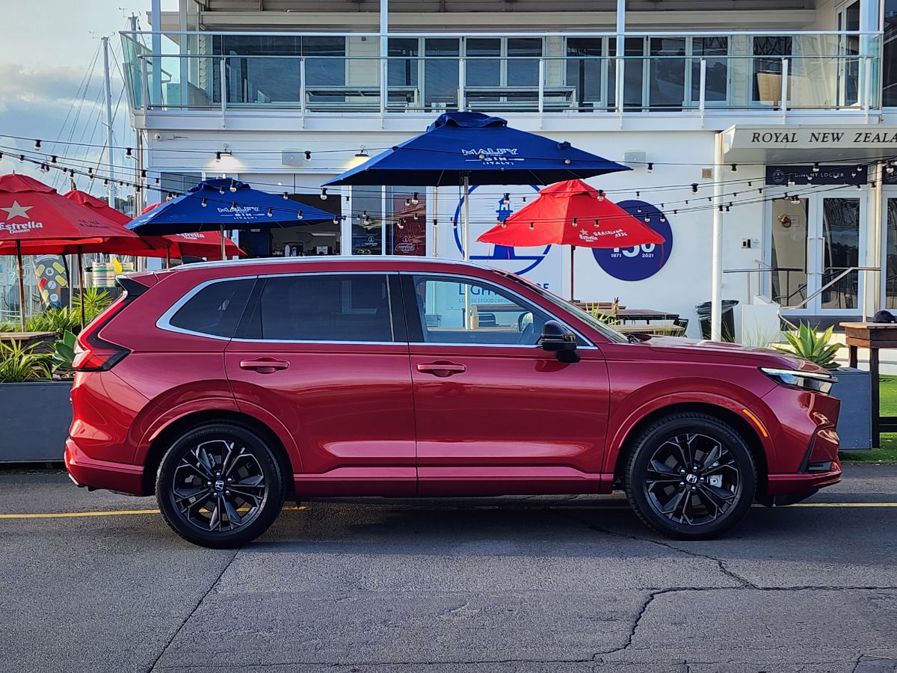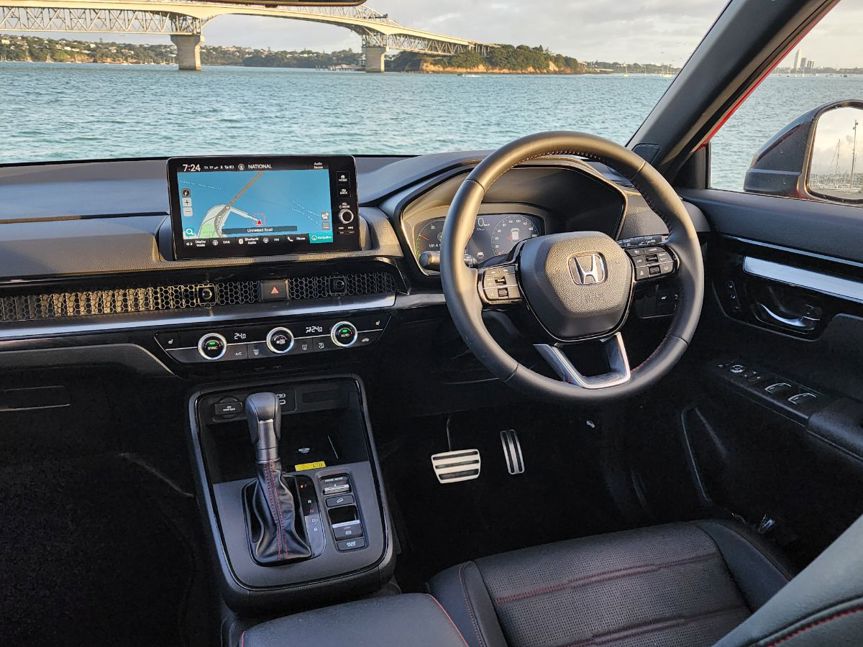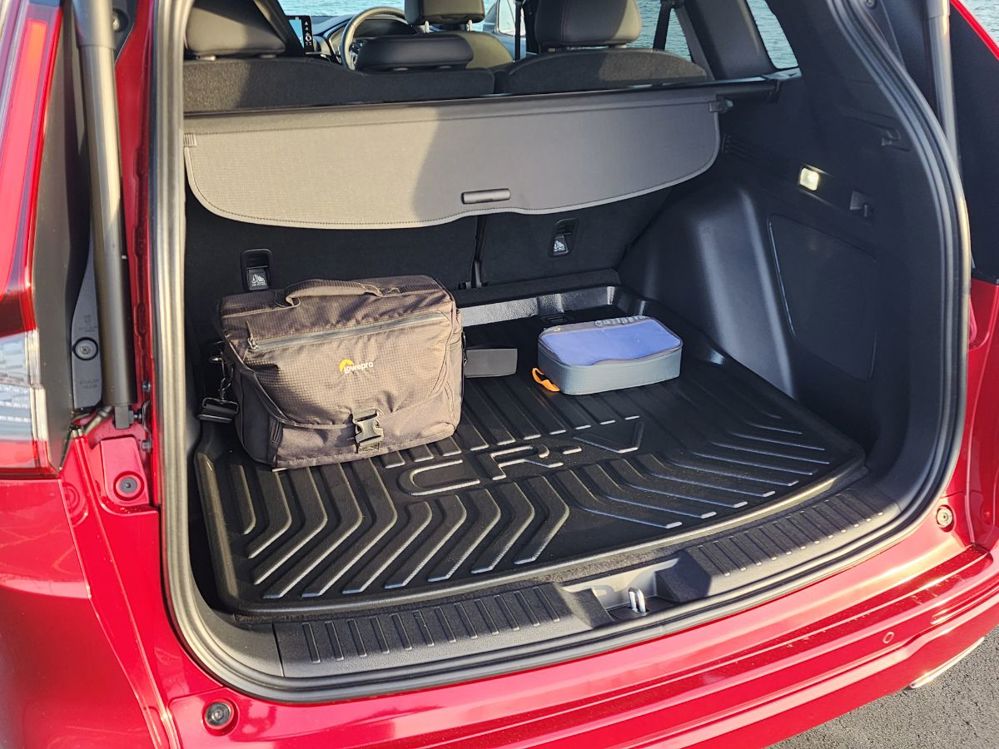After a slightly fraught introduction to the all-new Honda CR-V at the national media launch (honestly, don’t ask), we’ve now spent some extended time with the one everybody’s talking about, the e:HEV (that’s Honda-speak for hybrid).

To get the hybrid you have to go for the top $67k RS specification and give up any thought of all-wheel drive (that’s the entry $53k Sport with a standard petrol-turbo) or third-row seating ($57k Sport 7).
But you do get an iteration of the clever hybrid/range-extender technology we’ve already seen on the Jazz and especially ZR-V e:HEV models; like the latter, the CR-V uses the larger 2.0-litre petrol.
Quick refresh: the e:HEV petrol engine works mainly as a generator, supplying power to electric motors. One motor’s all-in on making electricity from that precious petrol, while the other drives the front wheels. It’s mainly electric drive in other words, although in some circumstances the 2.0-litre can engage with the electric motor directly to drive the wheels.

As with every other e:HEV we’ve driven, it sounds complicated but works seamlessly. You honestly don’t have to give it a second thought, and just drive the car; as long as you’re okay with some occasionally odd behaviour from the engine, given it’s making electricity rather than responding strictly to your throttle inputs. So sometimes, it’s revving when you don’t expect it; others, it’ll be spinning away at the lights and then shut down when you start driving.
Even on 19-inch wheels the ride is still really comfortable and nicely controlled. Yes, Honda is back on form.
You can select between various drive modes (including Sport) but they don’t make a massive difference and overall the powertrain is pretty happy doing its own thing. You will be too.

The CR-V shares its platform with the latest Civic and ZR-V, which is another way of saying it’s really well-sorted. In a family SUV context it’s great to drive, with decent steering and an impressive cornering stance.
The new CR-V does look pretty sharp on the outside. But it's not entirely original.
The RS has firmer suspension than the mainstream CR-V models, but even on 19-inch wheels the ride is still really comfortable and nicely controlled. Yes, Honda is back on form.

So the tech and driving experience are up to scratch, but how’s this new CR-V as a package? It looks sharp for a start, if not entirely original. There’s a lot of Mazda CX-5 at the front (that red doesn’t help) and it’s a bit Outlander at the back (ditto about the red). Odd, given Honda really has no need to copy those rivals. But overall it’s a crisp-looking machine and quite premium for a mainstream family SUV.
Inside, it’s very familiar if you’ve seen a Civic or ZR-V. But fresh-looking all the same.
What is weird is how different it looks to the smaller Honda ZR-V given they’re from the same family. The former is very amorphous in shape, the latter taut and angular.

Inside, it’s very familiar if you’ve seen a Civic or ZR-V. But very fresh-looking all the same, with lots of metal-effect trim and switchgear. All plastic of course, but there’s still a heft to the physical controls that is very pleasing.
Honda’s Sensing driver-assists all work well and are easy to operate – as is the infotainment, which is a relief after the ergonomic disaster zones of the old Civic (especially) and CR-V. Apple CarPlay is wireless, but you’ll need a cable for your Android phone.

It’s a bigger vehicle now and a truly useful family SUV, with generous rear seat space (the back bench slides, even) and a big 581-litre boot. The rear seatbacks fold nice and flat but the CR-V no longer features Honda’s brilliant Magic Seat setup. That’s likely to do with packaging for the AWD, 7-seat or plug-in hybrid (offered overseas but not in NZ) versions, but it’s a shame all the same. The CR-V is more spacious than ever… just not quite as smart.
It’s an expensive model now in RS form, but the CR-V is also a deeply impressive family car in terms of technology and practicality. There’s a fine balance of hybrid thrift, well-sorted ride/handling and genuine family space that means this CR-V ticks a lot of boxes.
ENGINE: 2.0-litre petrol four with dual electric motors and hybrid system POWER: 109kW/183Nm (petrol), 135kW/335Nm (electric) GEARBOX: Continuously variable automatic, FWD CONSUMPTION: 6.4l/100km (WLTP) PRICE: $67,000
How much is the Honda CR-V RS?
The top RS specification and fancy hybrid engine go together, so the price is a rather premium-sounding $67,000. The non-hybrid (including AWD and 7-seat) CR-Vs are $53,000-$57,000.
What are the key statistics for the Honda CR-V RS powertrain?
It's a somewhat confusing combination of a 109kW/183Nm petrol engine and 135kW/335Nm electric motor (which is what drives the wheels most of the time, remember). Honda doesn't quote a combined figure of any kind but our advice is: don't worry about it and just drive.
Is the Honda CR-V RS efficient?
The hybrid system is seamless and we found it to be very consistent. We achieved the 6.4l/100km official figure easily in both urban and open-road driving.
Is the Honda CR-V RS good to drive?
The disconnect between driver input and petrol engine behaviour takes some getting used to, but the operation is very smooth - way better than some plug-in hybrid powertrains we've drive lately. And the combination of comfy ride (even with the RS's 19in wheels and firmer suspension) and surefooted handling show Honda is back on form.
Is the Honda CR-V RS practical?
It's fairly big in medium-SUV terms and that means it's pretty practical. We miss Honda's Magic Seat setup (you still get it in a Jazz) but the CR-V has a big boot, and the back seat slides and reclines so you can mix and match passenger and cargo space.
What do we like about the Honda CR-V RS?
It's an incredibly polished overall package, there's a really solid feel to the whole thing and the hybrid technology works seamlessly, with consistent fuel economy.
What don’t we like about the Honda CR-V RS?
This model sure isn't cheap and it's a shame having the e:HEV powertrain precludes you from having AWD or 7 seats. Some might raise at eyebrow at the very modest 750kg tow rating.
What kind of person would the Honda CR-V RS suit?
It's a very mainstream family SUV at heart, so it'll be on a lot of shopping lists. It ticks many boxes, but those willing to spend the extra for the RS will be attracted by the fascinating hybrid technology and extra driver appeal of the RS's (slightly) sportier suspension.













